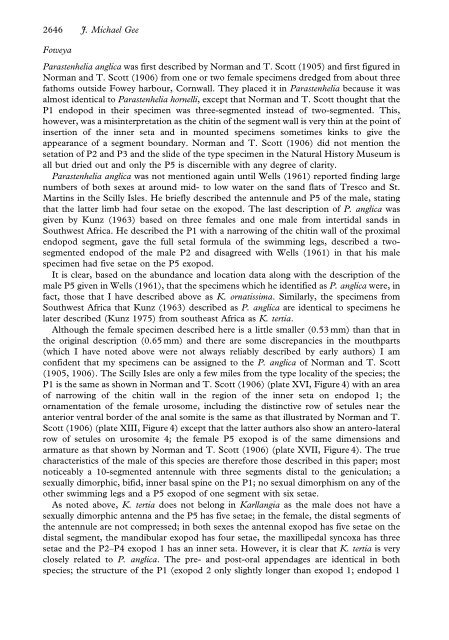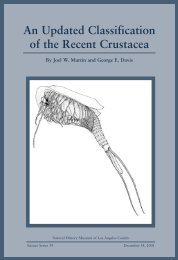Parastenheliidae (Copepoda: Harpacticoida) from ... - Luciopesce.net
Parastenheliidae (Copepoda: Harpacticoida) from ... - Luciopesce.net
Parastenheliidae (Copepoda: Harpacticoida) from ... - Luciopesce.net
You also want an ePaper? Increase the reach of your titles
YUMPU automatically turns print PDFs into web optimized ePapers that Google loves.
2646 J. Michael Gee<br />
Foweya<br />
Parastenhelia anglica was first described by Norman and T. Scott (1905) and first figured in<br />
Norman and T. Scott (1906) <strong>from</strong> one or two female specimens dredged <strong>from</strong> about three<br />
fathoms outside Fowey harbour, Cornwall. They placed it in Parastenhelia because it was<br />
almost identical to Parastenhelia hornelli, except that Norman and T. Scott thought that the<br />
P1 endopod in their specimen was three-segmented instead of two-segmented. This,<br />
however, was a misinterpretation as the chitin of the segment wall is very thin at the point of<br />
insertion of the inner seta and in mounted specimens sometimes kinks to give the<br />
appearance of a segment boundary. Norman and T. Scott (1906) did not mention the<br />
setation of P2 and P3 and the slide of the type specimen in the Natural History Museum is<br />
all but dried out and only the P5 is discernible with any degree of clarity.<br />
Parastenhelia anglica was not mentioned again until Wells (1961) reported finding large<br />
numbers of both sexes at around mid- to low water on the sand flats of Tresco and St.<br />
Martins in the Scilly Isles. He briefly described the antennule and P5 of the male, stating<br />
that the latter limb had four setae on the exopod. The last description of P. anglica was<br />
given by Kunz (1963) based on three females and one male <strong>from</strong> intertidal sands in<br />
Southwest Africa. He described the P1 with a narrowing of the chitin wall of the proximal<br />
endopod segment, gave the full setal formula of the swimming legs, described a twosegmented<br />
endopod of the male P2 and disagreed with Wells (1961) in that his male<br />
specimen had five setae on the P5 exopod.<br />
It is clear, based on the abundance and location data along with the description of the<br />
male P5 given in Wells (1961), that the specimens which he identified as P. anglica were, in<br />
fact, those that I have described above as K. ornatissima. Similarly, the specimens <strong>from</strong><br />
Southwest Africa that Kunz (1963) described as P. anglica are identical to specimens he<br />
later described (Kunz 1975) <strong>from</strong> southeast Africa as K. tertia.<br />
Although the female specimen described here is a little smaller (0.53 mm) than that in<br />
the original description (0.65 mm) and there are some discrepancies in the mouthparts<br />
(which I have noted above were not always reliably described by early authors) I am<br />
confident that my specimens can be assigned to the P. anglica of Norman and T. Scott<br />
(1905, 1906). The Scilly Isles are only a few miles <strong>from</strong> the type locality of the species; the<br />
P1 is the same as shown in Norman and T. Scott (1906) (plate XVI, Figure 4) with an area<br />
of narrowing of the chitin wall in the region of the inner seta on endopod 1; the<br />
ornamentation of the female urosome, including the distinctive row of setules near the<br />
anterior ventral border of the anal somite is the same as that illustrated by Norman and T.<br />
Scott (1906) (plate XIII, Figure 4) except that the latter authors also show an antero-lateral<br />
row of setules on urosomite 4; the female P5 exopod is of the same dimensions and<br />
armature as that shown by Norman and T. Scott (1906) (plate XVII, Figure 4). The true<br />
characteristics of the male of this species are therefore those described in this paper; most<br />
noticeably a 10-segmented antennule with three segments distal to the geniculation; a<br />
sexually dimorphic, bifid, inner basal spine on the P1; no sexual dimorphism on any of the<br />
other swimming legs and a P5 exopod of one segment with six setae.<br />
As noted above, K. tertia does not belong in Karllangia as the male does not have a<br />
sexually dimorphic antenna and the P5 has five setae; in the female, the distal segments of<br />
the antennule are not compressed; in both sexes the antennal exopod has five setae on the<br />
distal segment, the mandibular exopod has four setae, the maxillipedal syncoxa has three<br />
setae and the P2–P4 exopod 1 has an inner seta. However, it is clear that K. tertia is very<br />
closely related to P. anglica. The pre- and post-oral appendages are identical in both<br />
species; the structure of the P1 (exopod 2 only slightly longer than exopod 1; endopod 1











